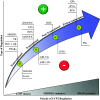UCP2, a mitochondrial protein regulated at multiple levels
- PMID: 23807210
- PMCID: PMC11114077
- DOI: 10.1007/s00018-013-1407-0
UCP2, a mitochondrial protein regulated at multiple levels
Abstract
An ever-increasing number of studies highlight the role of uncoupling protein 2 (UCP2) in a broad range of physiological and pathological processes. The knowledge of the molecular mechanisms of UCP2 regulation is becoming fundamental in both the comprehension of UCP2-related physiological events and the identification of novel therapeutic strategies based on UCP2 modulation. The study of UCP2 regulation is a fast-moving field. Recently, several research groups have made a great effort to thoroughly understand the various molecular mechanisms at the basis of UCP2 regulation. In this review, we describe novel findings concerning events that can occur in a concerted manner at various levels: Ucp2 gene mutation (single nucleotide polymorphisms), UCP2 mRNA and protein expression (transcriptional, translational, and protein turn-over regulation), UCP2 proton conductance (ligands and post-transcriptional modifications), and nutritional and pharmacological regulation of UCP2.
Conflict of interest statement
The authors declare that they have no conflicts of interest.
Figures




Similar articles
-
Metformin induces oxidative stress in white adipocytes and raises uncoupling protein 2 levels.J Endocrinol. 2008 Oct;199(1):33-40. doi: 10.1677/JOE-08-0278. Epub 2008 Aug 7. J Endocrinol. 2008. PMID: 18687824
-
The RNA binding protein hnRNP-K mediates post-transcriptional regulation of uncoupling protein-2 by angiopoietin-1.Cell Signal. 2014 Jul;26(7):1379-84. doi: 10.1016/j.cellsig.2014.03.005. Epub 2014 Mar 15. Cell Signal. 2014. PMID: 24642125 Free PMC article.
-
Effect of berberine on expressions of uncoupling protein-2 mRNA and protein in hepatic tissue of non-alcoholic fatty liver disease in rats.Chin J Integr Med. 2011 Mar;17(3):205-11. doi: 10.1007/s11655-011-0668-4. Epub 2011 Feb 27. Chin J Integr Med. 2011. PMID: 21359922
-
[Mitochondrial uncoupling protein UCP2 and cancer].Sheng Li Ke Xue Jin Zhan. 2013 Jun;44(3):233-6. Sheng Li Ke Xue Jin Zhan. 2013. PMID: 24027834 Review. Chinese. No abstract available.
-
Neuroprotective role of mitochondrial uncoupling protein 2 in cerebral stroke.J Cereb Blood Flow Metab. 2009 Jun;29(6):1069-78. doi: 10.1038/jcbfm.2009.4. Epub 2009 Feb 25. J Cereb Blood Flow Metab. 2009. PMID: 19240738 Review.
Cited by
-
The effect of Nrf2 deletion on the proteomic signature in a human colorectal cancer cell line.BMC Cancer. 2022 Sep 13;22(1):979. doi: 10.1186/s12885-022-10055-y. BMC Cancer. 2022. PMID: 36100939 Free PMC article.
-
Citrate shuttling in astrocytes is required for processing cocaine-induced neuron-derived excess peroxidated fatty acids.iScience. 2022 Oct 20;25(11):105407. doi: 10.1016/j.isci.2022.105407. eCollection 2022 Nov 18. iScience. 2022. PMID: 36389000 Free PMC article.
-
UCP2-SIRT3 Signaling Relieved Hyperglycemia-Induced Oxidative Stress and Senescence in Diabetic Retinopathy.Invest Ophthalmol Vis Sci. 2024 Jan 2;65(1):14. doi: 10.1167/iovs.65.1.14. Invest Ophthalmol Vis Sci. 2024. PMID: 38175638 Free PMC article.
-
UCP2 silencing aggravates mitochondrial dysfunction in astrocytes under septic conditions.Mol Med Rep. 2019 Nov;20(5):4459-4466. doi: 10.3892/mmr.2019.10721. Epub 2019 Oct 2. Mol Med Rep. 2019. PMID: 31702042 Free PMC article.
-
N-3 polyunsaturated fatty acids decrease levels of doxorubicin-induced reactive oxygen species in cardiomyocytes -- involvement of uncoupling protein UCP2.J Biomed Sci. 2014 Nov 18;21(1):101. doi: 10.1186/s12929-014-0101-3. J Biomed Sci. 2014. PMID: 25407516 Free PMC article.
References
-
- Brand MD, Brindle KM, Buckingham JA, Harper JA, Rolfe DF, Stuart JA. The significance and mechanism of mitochondrial proton conductance. Int J Obes Relat Metab Disord. 1999;23(Suppl 6):S4–S11. - PubMed
-
- Klingenberg M. Uncoupling protein—a useful energy dissipator. J Bioenergy Biomembr. 1999;31:419–430. - PubMed
-
- Jezek P, Urbankova E. Specific sequence of motifs of mitochondrial uncoupling proteins. IUBMB Life. 2000;49:63–70. - PubMed
-
- Andrews ZB, Diano S, Horvath TL. Mitochondrial uncoupling proteins in the CNS: in support of function and survival. Nat Rev Neurosci. 2005;6:829–840. - PubMed
-
- Arsenijevic D, Onuma H, Pecqueur C, Raimbault S, Manning BS, Miroux B, Couplan E, Alves-Guerra MC, Goubern M, Surwit R, et al. Disruption of the uncoupling protein-2 gene in mice reveals a role in immunity and reactive oxygen species production. Nat Genet. 2000;26:435–439. - PubMed
Publication types
MeSH terms
Substances
LinkOut - more resources
Full Text Sources
Other Literature Sources

